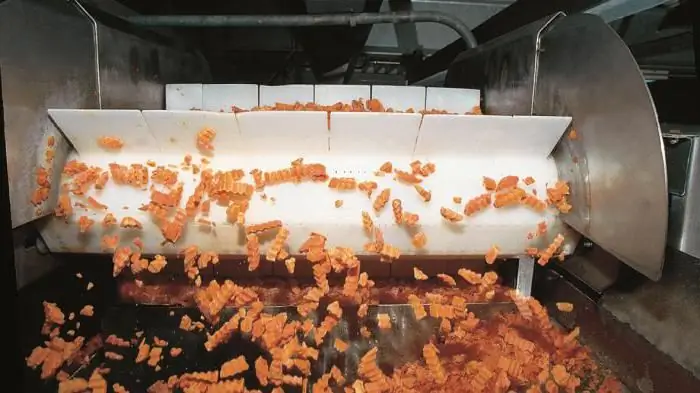2025 Author: Howard Calhoun | [email protected]. Last modified: 2025-01-24 13:10:47
Building partnerships in business can be carried out using tolling schemes. Corresponding legal relations are established taking into account the requirements of the Civil Code, as well as the sources of law governing financial accounting at Russian enterprises. What is their specificity? How are the procedures that characterize tolling schemes taken into account?

Processing of tolling raw materials: the essence of legal relations
To begin with, let's define what the considered mechanisms of interaction between enterprises are.
The tolling scheme of legal relations between economic entities involves the acceptance by one party of the transaction - the processor - of materials from the customer in the status of a toller for the purpose of their further processing or manufacturing of any product. At the same time, the cost of the relevant materials is not paid, while the result of their processing, including the finished product, is transferred to the customer on time.
An important aspect of legal relations for whichtypical tolling scheme - accounting. It is carried out using the Chart of Accounts, approved by law. Own tolling raw materials are reflected in account 003, which refers to off-balance sheet. Direct accounting for the costs associated with the processing of materials can be carried out separately from a similar procedure, which characterizes the standard release of goods by the company (later in the article we will consider this feature in more detail). At the same time, the structure of the corresponding costs may be similar to the one that characterizes the processing of the enterprise's own materials, with the exception of indicators of the direct cost of tolling materials, as well as costs associated with the sale of manufactured products.

The parties to the legal relationship sign, in the case of choosing such an interaction mechanism as a tolling scheme, an agreement. Consider its features.
Agreement with a tolling scheme: what are its features?
In fact, the agreement in question is a subspecies of a work contract. Thus, when compiling it, the parties to legal relations should be guided primarily by the provisions of the Civil Code of the Russian Federation.
In the contract, which is concluded under the tolling scheme, are fixed, in particular:
- the name and volume of raw materials that are transferred from the customer to the processor;
- the name and characteristics of products that must be made from customer-supplied raw materials;
- the deadlines in which one party must deliver the materials, andthe other is to recycle them in due order;
- the cost of processing, as well as the order in which the parties are expected to settle;
- a mechanism for transporting tolling raw materials and the results of their processing;
- parameters characterizing the intensity of consumption of raw materials, setting the norms for technological losses, the formation of industrial waste, the formation of natural loss in the processing of raw materials to be supplied.

Of course, other conditions may be fixed in the contract. For example, directly the method of settlement of the parties (in cash or part of raw materials or finished products).
The tolling scheme of legal relations also involves the formation of a fairly large number of documents that supplement the contract in question. Let's consider their specifics in more detail.
Documents for a tolling scheme: application features
The first step in the implementation of the contract, the features of which we studied above, is the supply of raw materials to the processor. Upon completion of this procedure, a special act is most often formed, in which the name, volume, and also the cost of raw materials are recorded in accordance with the contract. At the same time, information about VAT is not reflected in the document, since the scheme of the tolling method of processing raw materials does not imply the calculation of VAT by the customer, as well as the emergence of the right to deduct the corresponding tax from the other side of the legal relationship.
Use invoices
Another document that mightbe issued when transferring raw materials from the customer to the processor - an invoice. However, it may also be accompanied by a bill of lading or a receipt. In the relevant document, it is necessary to fix that the raw materials are transferred by the customer precisely according to the tolling scheme. At the same time, it is recommended to record in the invoice information about the agreement between the parties - the number of the document, the date of its preparation.
Receipt of customer-supplied raw materials is most often registered at the processor's warehouse. This procedure involves the use, first of all, of a receipt order - it also reflects the fact that the parties to legal relations use a tolling scheme for the transfer and processing of raw materials.
The next group of documents is issued directly during the implementation of certain operations in the warehouse - such as, for example, the transfer of raw materials to the production workshop for processing. Various invoices may also apply here.
Once finished products are made from customer-supplied raw materials, they can be temporarily placed in a warehouse in order to prepare for shipment. The fact that the finished product has arrived at the appropriate subdivision of the organization that processes raw materials is also documented through the use of a special invoice. In turn, when goods are released to the customer, a separate optimized invoice is applied.
Reporting on tolling schemes
The next document, which is drawn up within the framework of legal relations between the customer and the processor of customer-supplied raw materials, is a report on the use of the corresponding resource. Hisdrawing up is required by the Civil Code. This report reflects the name and volume:
- raw materials that have been obtained and processed;
- finished product released by the processor;
- waste generated during production.
After the processing of customer-supplied raw materials is completed, an acceptance certificate is issued. It fixes the cost of fulfilling an order for the manufacture of products by a processor. Also, the party of legal relations that released the goods within the framework of such a mechanism of legal relations as a tolling scheme must provide the customer with an invoice.
Now let's consider the nuances of taxation that characterize the considered format of legal relations in business.
Taxes under tolling scheme
The cost of those materials that were received under the tolling scheme does not increase the tax base of the company that under the contract carries out processing. However, if we are talking about the sale of services related to the production of products from customer-supplied raw materials, then the tax base is formed. It is calculated based on the cost of processing raw materials or materials, but excluding taxes.

In this case, VAT is calculated at a rate of 18%. The tax on those materials, works and services that were paid in order to ensure the processing of raw materials can be claimed by the processor for deduction.
The income of the company that processed the materials to be supplied is determined as the cost of work under the contract. In turn, the costs of the processor are calculated based on the costs,associated with the performance of the relevant work. The cost of raw materials is not taken into account.
The accounting department of the company must allocate direct costs of the release of products to the balance of work in progress. Indirect costs are fixed directly when they are incurred.
Accounting entries
As we noted above, one of the most important aspects of such a mechanism of legal relations as a tolling scheme is the accounting of its constituent operations. Let us consider in more detail what kind of wiring can be involved in this case.
When tolling processing, the following basic operations are carried out:
- receiving an advance payment under the contract (reflected by posting Debit 51, Credit 62-2);
- charge VAT on the amount received (Debit 76, Credit 68);
- reflection of the cost of raw materials, which is accepted to the warehouse (Debit 003, sub-account "Warehouse");
- write-off of raw materials for further processing (Credit 003);
- accounting of customer-supplied raw materials transferred to the workshop (Dt 003, sub-account "Processing");
- reflection of costs related to the processing of raw materials (Dt 20, Ct 02);
- acceptance of finished products from the workshop (Dt 002);
- write-off of used raw materials (Kt 003, sub-account "Processing");
- write-off of expenses related to processing (Dt 90-2, Ct 20);
- reflection of income under the contract with the customer (Dt 62-1, Kt 90-1);
- VAT charge based on the cost of processing raw materials (Dt 90-3, Kt 68);
- acceptance of VAT for deduction (Dt 68, Kt 76);
- implementationshipment of finished products to the customer (Kt 002);
- implementation of prepayment offset (Dt 62-2, Kt 62-1);
- receiving payment from the customer (Dt 51, Ct 62-1).
If the processor has several customers, then accounting in the tolling scheme is carried out using separate statements for each counterparty, which record information about the materials received, as well as products resulting from their processing.

What other nuances can characterize accounting within the framework of legal relations in question? Above, we noted that the scheme of raw materials to be supplied by the parties to legal relations may require accounting in the accounting registers of the processor, which is separate from the corresponding procedure, which characterizes the standard release of goods. Let's study this nuance in more detail.
Separate accounting for tolling and standard production
Indeed, one of the most important aspects of the legal relations under consideration is also the separate accounting of raw materials and finished products, which characterize legal relations within the framework of tolling and standard production schemes. What are its features?
The main difficulty in accounting, if both a tolling scheme of work with a counterparty and a standard one, in which the company itself produces goods, is used, is to separate accounting procedures for the same type of product. If these are 2 different types of products, then the solution of the problem is greatly facilitated. But if the corresponding types of goods are the same, then it is more difficult to keep records.
According to experts, the tolling scheme should be accompanied by the use, first of all, of accounting mechanisms that differ from those that characterize the standard output of goods by an enterprise. This problem is not easy to solve. One of the tools to solve it can be the use of different accounting accounts.
Thus, a tolling scheme may consist of procedures reflected on account 003, and a standard one using account 10. As for accounting for finished products, accounts 002 and 43, respectively, can be used. It is assumed that in the debit of account 20, only the cost of the enterprise's own materials will be recorded. Tolling raw materials, in turn, are not taken into account in costs. On the credit of account 20, the cost of finished products should be fixed, while correspondence will be established on the debit of account 43 or 40. Correspondence in the case of processing will be on the debit of account 90-2, as well as the credit of account 20.

The tolling scheme of production, when it comes to the production of identical goods, involves the distribution of products into 2 categories - own and produced under an agreement with a counterparty based on the norms characterizing the consumption of raw materials. An alternative variant of separate reflection of operations for tolling and standard production is also possible. It assumes that customer-supplied raw materials, when released to the workshop, are debited from account 003 and at the same time accounted for by the accountant on the balance sheet by posting using the debit of account 10 andcredit 76. In this case, correspondence is used on the debit of account 20 and the credit of account 20 - when the cost of materials is written off to production, as well as on the debit of account 43 and credit 20 - when finished products are posted.
Of course, separate accounting in the tolling scheme can also be carried out according to other principles, for example, in accordance with industry regulations, recommendations from departments, taking into account the specifics of a particular enterprise.
Automation of accounting for tolling schemes: basic solutions
The procedures we have considered, which characterize accounting within the framework of tolling schemes, are in many cases implemented at large enterprises, and their implementation to the required extent can be very laborious without the use of automation tools.
It can be quite a convenient tool of the appropriate type if the enterprise uses such a mechanism of legal relations as a tolling scheme, "1C: UPP". That is, it is supposed to use a popular accounting program in a modification adapted to take into account the procedures in question. This solution is characterized by a very convenient interface that allows you to consistently implement the necessary procedures.

Automation of accounting: application of the 1C program
If the task is to implement legal relations, which includes a tolling scheme, "UPP" assumes its solution within the framework of algorithms that can be applied both by the customer and the processor. For example, ifthe company transfers raw materials for further release to the counterparty, then the specified program involves the solution of the task in several stages:
- forming an order to the supplier;
- transfer of materials for further processing;
- registration of services provided by the processor under the contract.
The corresponding modification of "1C" allows you to keep records using the necessary accounting entries, subject to the correct formation of correspondence between them.
Recommended:
Accounting documents are The concept, rules for registration and storage of accounting documents. 402-FZ "On Accounting". Article 9. Primary accounting documents

Proper execution of accounting documentation is very important for the process of generating accounting information and determining tax liabilities. Therefore, it is necessary to treat documents with special care. Specialists of accounting services, representatives of small businesses who keep independent records should know the main requirements for the creation, design, movement, storage of papers
Meat: processing. Equipment for meat and poultry processing. Production, storage and processing of meat

Information of state statistics show that the volume of meat, milk and poultry consumed by the population has significantly decreased in recent years. This is caused not only by the pricing policy of manufacturers, but also by the banal shortage of these products, the required volumes of which simply do not have time to produce. But meat, the processing of which is an extremely profitable business, is very important for human he alth
Cash and credit operations of banks. Types of banking operations

The main operations that a commercial bank performs are credit and cash. What are their specifics? According to what rules are they carried out?
Accounting for working hours in the summary accounting. Summarized accounting of the working time of drivers with a shift schedule. Overtime hours with summarized accounting of wor

The Labor Code provides for work with a summarized accounting of working hours. In practice, not all enterprises use this assumption. As a rule, this is due to certain difficulties in the calculation
Types of banking operations. Settlement and cash services. Operations of banks with securities

Before you know what types of banking transactions exist, you need to understand some of the most important definitions. For example, what is the institution in question itself? In modern economic terminology, the bank acts as a financial and credit unit that performs all kinds of operations with both money and securities

